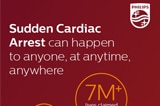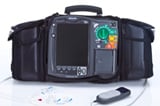Philips celebrates 20th anniversary of its first AED designed for public access with campaign to raise awareness of sudden cardiac arrest
September 22, 2016
Amsterdam, the Netherlands – Royal Philips (NYSE: PHG, AEX: PHIA) today announced the 20th anniversary and 1.5 millionth sale of its HeartStart line of automated external defibrillators (AEDs), the first AED designed for the layperson. With these milestones, the company is launching a campaign aimed at raising awareness around the prevalence of sudden cardiac arrest (SCA), with the goal of educating people about using AEDs and how they can lead the way to save a life. Despite the widespread availability of AEDs today, people are not always aware of AEDs, don’t know how easy they are to use, and may still hesitate to intervene when someone is experiencing a SCA. Philips aims to showcase the ease of use and importance of AEDs, and empower laypeople to take action to help save a life. Sudden cardiac arrest is a leading cause of death and a major health problem in Europe and the U.S. Approximately 420,000 people experience EMS-assessed out-of-hospital non-traumatic SCA each year in the U.S. and 275,000 in Europe1,2. When bystanders intervene by giving CPR and using AEDs, however, 4 out of 10 victims survive3. CPR may extend a victim’s life temporarily, but it alone cannot save the majority of SCA victims. Through this campaign, Philips is engaging with medical experts and survivors of cardiac arrest to move past one of the biggest barriers today: giving the average person the confidence to use an AED in an emergency. “Today’s AEDs couldn’t be easier to use – you open the box and the device talks you through the steps – yet, despite this, people are still hesitant to intervene when they witness someone experiencing a sudden cardiac arrest episode,” said Dr. Joe Frassica, chief medical and innovation officer, Philips and chief science officer, Philips Research North America. “We need to ensure that people know what AEDs are, how to use them and understand that they can, in fact, be used by anyone. Those moments between someone’s heart stopping and when the emergency responders get to the scene are crucial. For every additional person equipped with the knowledge and confidence to intervene with an AED, there is potential for another life saved.” The reality about sudden cardiac arrest is it can happen to anyone, anywhere at any time4. While SCA is most common in people over 40 years old, 9,500 cases of SCA happen to children under the age of 185. Many bystanders mistakenly believe it is best to wait for professional help to arrive to the scene of a SCA. For the best chance of survival, an AED should be used within three to five minutes after collapse6. For every minute that passes without CPR and defibrillation, an SCA victim's chance of survival decreases by 7% to 10%7. After 10 minutes, very few SCA victims survive8. However, being able to provide immediate treatment is crucial, as only 10.6 percent of SCA victims survive9. On average, EMS teams in the U.S. take 6 to 12 minutes to arrive on the scene of a SCA10. With bystander intervention and treatment with an AED, the survival percentage triples to 31.4 percent11. “Over eight years ago, I was sitting at lunch discussing senior prom plans with friends when I suddenly went unconscious, fell out of my seat and began to convulse,” said Lindsay Hayden, a survivor of cardiac arrest. “I was having a sudden cardiac arrest. I was just 17 at the time. A classmate and close friend had died of cardiac arrest just a year and a half prior to my episode, and his parents placed an AED in my school in his memory. That same AED helped save my life. Without the help of a classmate and the use of the AED, I believe I wouldn’t be here today. Sudden cardiac arrest doesn’t discriminate and it really can happen to anyone. I was lucky that my classmate recognized that I was having a cardiac arrest, was trained in CPR, and knew what an AED was. But luck shouldn’t be a vital component to survival.” Philips launched its first public access AED, Forerunner by Heartstream, in 1996 and set the pace in the industry with milestones and innovation breakthroughs, such as its pediatric capability, throughout its history. Philips created AEDs for the layperson to use when faced with an extraordinary moment giving an untrained responder the confidence to act quickly, decisively and lead the way to save a life. Since this innovation and product name change to HeartStart, Philips’ AEDs have helped to save many lives. In 2015, HeartStart defibrillators were present on board 80 percent of major U.S. airlines, dozens of regional airlines and many of the largest international carriers. HeartStart can also be found in many of the busiest U.S. airports, one of the largest bus and coach producers in Europe, 43 professional sports team and 85 percent of Fortune 500 companies. Today, HeartStart automated defibrillators are located in major public places, making AEDs more accessible so that those in need can receive the help they need when they need it. To learn more about our survivors and Philips HeartStart products, please visit: https://www.usa.philips.com/healthcare/articles/aed-solutions. For more information on Philips global efforts in supporting World Heart Day on Sept. 29, visit www.myheartisunique.com. 1 Incidence of EMS-treated out-of-hospital cardiac arrest in the United States, Thomas D. Rea; Mickey S. Eisenberg; Greg Sinibaldi; Roger D. White, Resuscitation, September 16, 2016 3 About SCA, Mary M. Newman, Sudden Cardiac Arrest Foundation, September 16, 2016 4 Sudden Cardiac Arrest Is Not on Consumers' Radar, According to a New Study by the Sudden Cardiac Arrest Foundation, Sudden Cardiac Arrest Foundation, September 16, 2016 5 About SCA, Mary M. Newman, Sudden Cardiac Arrest Foundation, September 16, 2016 6 Sudden Cardiac Arrest FAQs, Sudden Cardiac Arrest Foundation, September 16, 2016 7 CPR Facts and Stats, American Heart Association, September 16, 2016 8 About AEDs, Sudden Cardiac Arrest Association, September 16, 2016 9 Heart Disease and Stroke Statistics—2015 Update, Dariush Mozaffarian; et. al, American Heart Association, September 16, 2016 10 Heart Disease and Stroke Statistics—2015 Update, Dariush Mozaffarian; et. al, American Heart Association, September 16, 2016 11 AHA Releases 2015 Heart and Stroke Statistics, Sudden Cardiac Arrest Foundation, September 16, 2016


For further information, please contact:
Kathy O’Reilly Philips Global Communications Tel.: +1 978-221-8919 E-mail: kathy.oreilly@philips.com Twitter: @kathyoreilly Ingrid Mitchell Philips Patient Care and Monitoring Solutions Tel: +1 978-482-5949 Mobile: +1 617-599-6624 E-mail: ingrid.e.mitchell@philips.com
About Royal Philips Royal Philips (NYSE: PHG, AEX: PHIA) is a leading health technology company focused on improving people’s health and enabling better outcomes across the health continuum from healthy living and prevention, to diagnosis, treatment and home care. Philips leverages advanced technology and deep clinical and consumer insights to deliver integrated solutions. The company, headquartered in the Netherlands, is a leader in diagnostic imaging, image-guided therapy, patient monitoring and health informatics, as well as in consumer health and home care. Philips’ health technology portfolio generated 2015 sales of EUR 16.8 billion and employs approximately 69,000 employees with sales and services in more than 100 countries. News about Philips can be found at www.philips.com/newscenter.
